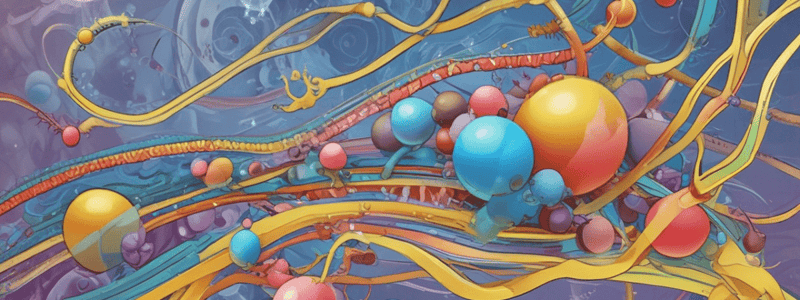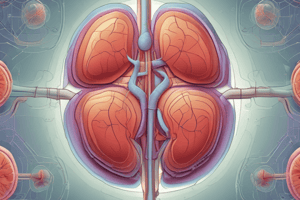Podcast
Questions and Answers
What is the primary function of potassium ions in maintaining resting potential?
What is the primary function of potassium ions in maintaining resting potential?
- To allow rapid repolarization of the membrane
- To enable the membrane to recover before the next action potential (correct)
- To increase the conduction velocity of the action potential
- To prolong the action potential duration
What is the normal range of potassium levels in plasma?
What is the normal range of potassium levels in plasma?
- 5.5-6.0 mmol/L
- 3.5-5.0 mmol/L (correct)
- 7.0-8.0 mmol/L
- 2.0-3.0 mmol/L
What is the most common complication of diuretic therapy that can lead to hypokalaemia?
What is the most common complication of diuretic therapy that can lead to hypokalaemia?
- Heart failure
- Renal disease
- Elimination of potassium in the urine (correct)
- Hypertension
What is the electrophysiological consequence of hypokalaemia on contractile cells?
What is the electrophysiological consequence of hypokalaemia on contractile cells?
What is the most common cause of hyperkalaemia?
What is the most common cause of hyperkalaemia?
What is the consequence of hyperkalaemia on the action potential duration?
What is the consequence of hyperkalaemia on the action potential duration?
What is the consequence of hyperkalaemia on the conduction velocity of the action potential?
What is the consequence of hyperkalaemia on the conduction velocity of the action potential?
What is the consequence of hypokalaemia on the activity of sodium-calcium exchangers?
What is the consequence of hypokalaemia on the activity of sodium-calcium exchangers?
Flashcards are hidden until you start studying
Study Notes
Normal K+ Levels
- K+ is a major intracellular cation, concentrated intracellularly through the Na+-K+ ATPase pump, which pumps 3 Na+ out and 2 K+ in.
- K+ ions maintain resting potential, allowing membranes to recover before the next action potential.
- Normal K+ levels in plasma range from 3.5-5.0 mmol/L.
Hypokalaemia (Low K+ Levels)
- Hypokalaemia occurs when there is less potassium in the plasma.
- It commonly occurs as a complication of diuretic therapy, such as in the treatment of hypertension, renal disease, and heart failure.
- Diuretics can eliminate potassium in the urine, leading to hypokalaemia.
- Electrophysiological consequences include:
- Resting membrane hyperpolarization, as inward rectifier channels move more K+ outside, making the resting membrane potential (RMP) more negative.
- Action potential (AP) duration prolongation.
- Delayed repolarization (phase 3), as delayed rectifier channels move less K+ outside, prolonging the AP.
- Predisposition to early after depolarization (EAD), which mediates arrhythmias.
Hyperkalaemia (High K+ Levels)
- Hyperkalaemia occurs when there is excess K+ outside the cell due to inward rectifier channels.
- It commonly occurs due to chronic or acute kidney failure.
- Electrophysiological consequences include:
- Resting membrane potential becomes more positive.
- AP duration shortening.
- Slow conduction velocity, as phase 3 happens quickly, leading to inactivation of Na+ channels.
- Predisposition to heart block, asystole, and re-entry currents.
Studying That Suits You
Use AI to generate personalized quizzes and flashcards to suit your learning preferences.



